Nubian Goat
Capra aegagrus hircus
The Nubian is a relatively large, proud, and graceful dairy goat that traces its ancestry to India and Egypt.
Advertisement
Nubian Goat Scientific Classification
- Kingdom
- Animalia
- Phylum
- Chordata
- Class
- Mammalia
- Order
- Artiodactyla
- Family
- Bovidae
- Genus
- Capra
- Scientific Name
- Capra aegagrus hircus
Read our Complete Guide to Classification of Animals.
Nubian Goat Conservation Status
Nubian Goat Facts
- Name Of Young
- kid
- Group Behavior
- Herd
- Fun Fact
- The Nubian is a relatively large, proud, and graceful dairy goat that traces its ancestry to India and Egypt.
- Estimated Population Size
- 924 million
Nubian Goat Physical Characteristics
- Color
- Black
- White
- Tan
- Chestnut
- Skin Type
- Hair
- Lifespan
- 15 years in captivity, 12 years in the wild
- Weight
- 135lbs
- Age of Sexual Maturity
- six months
View all of the Nubian Goat images!
Lop-ear Nubian goats have African, Middle Eastern, and British ancestry. This mixed-breed, domestic goat is famous for its rich milk, long ears, and vocal personality.
Nubian goats are friendly, intelligent, and highly curious. Read on to learn interesting facts about these popular goats.
5 Nubian Goat Facts
- Nubian goats are the most popular dairy goat in the U.S.
- Nubian goats produce milk that has 4% to 5% butterfat, which is ideal for making cheese, cream, and other dairy products.
- Nubian goats are known for their size and their loud vocalizations.
- British dairy farmers created the breed in 1893.
- Lop-ear goats remain fertile their entire lives.
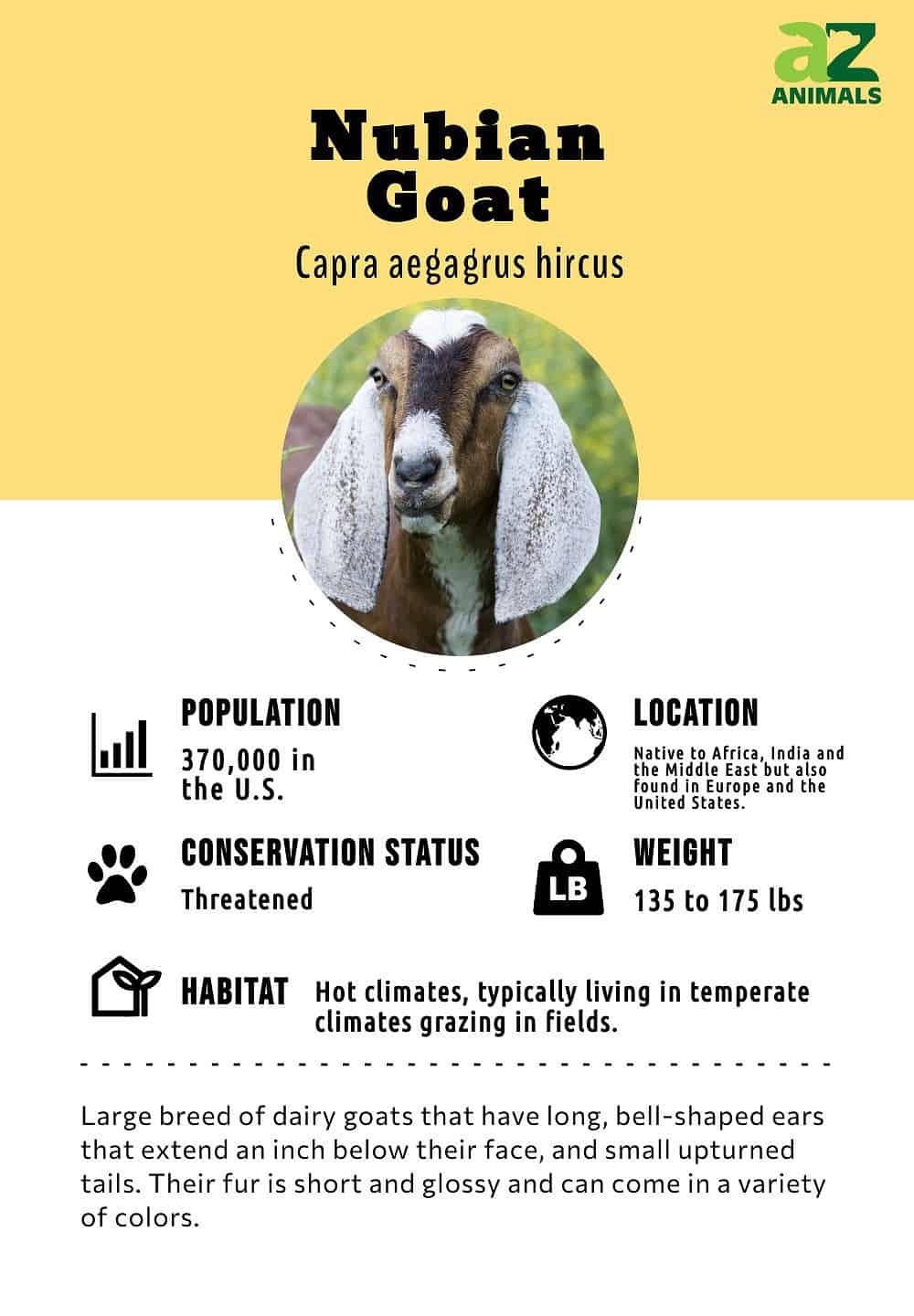
Scientific Name
The Lop-ear goat’s scientific name is Capra aegagrus hircus. Nubian goats are sometimes called lop-ear goats or Anglo-Nubian goats.
Evolution And History
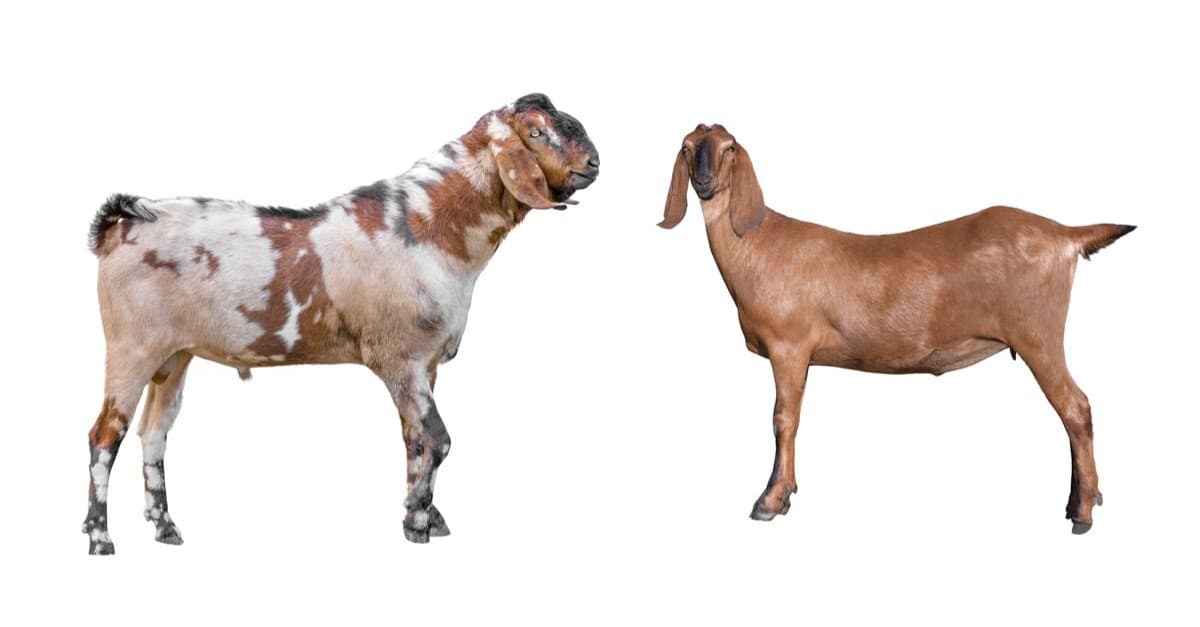
Nubian Goat female and male were created during the 19th century.
©photomaster/Shutterstock.com
The goat can trace its lineage back more than 11,000 years to the wild bezoar ibex. This ibex was kept in herds by Neolithic farmers in western Asia and as farming became more prevalent, livestock began to develop into domesticated animals. It is believed that the Nubian goat is one of the older breeds of goats, having been created during the 19th century by crossing the old English Milch goat from Britain and the Zariby and Nubian goats that were brought over from India, Egypt, and Russia.
Types Of
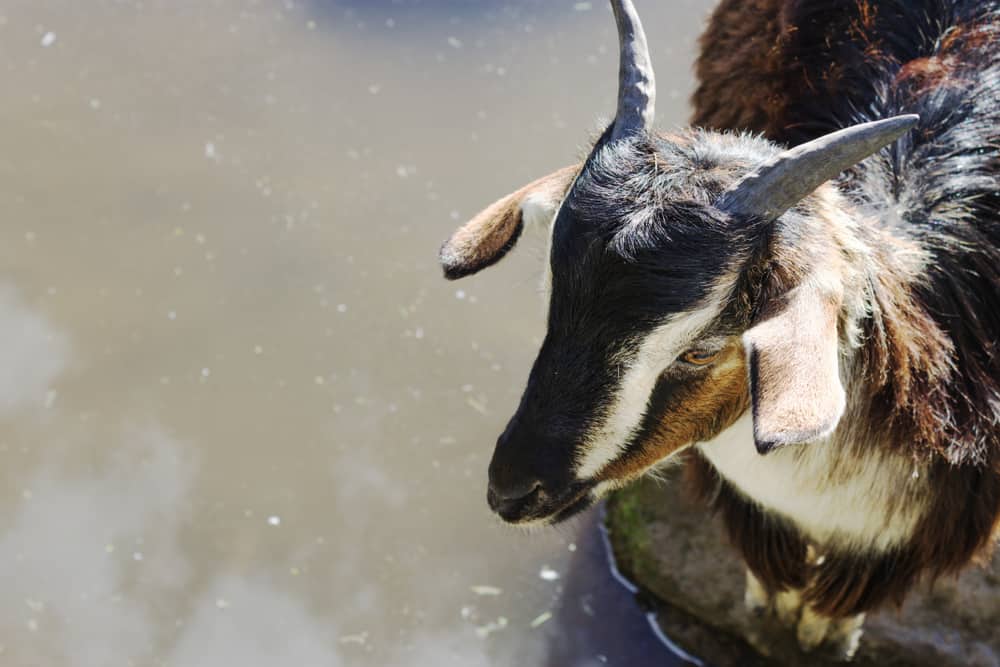
One of the rarest goat breeds in the world, the New Zealand Arapawa goat is, according to the American Livestock Breeds Conservancy, critically close to extinction.
©Molly NZ/Shutterstock.com
The Nubian goat is a breed of dairy goat, of which there are over 75 different breeds. The Nubian goat is known for its high butterfat content and with the exception of the Boer goat, produces the most butterfat than any other breed. Here are the just a few of these breeds:
- Nubian Goat
- Boer Goat – the world’s largest goat, produces milk with the highest context of butterfat.
- American Pygmy Goat – the world’s smallest goat
- Nigerian Dwarf Goat – the best goat to have as a pet
- Saanen Goat
- Spanish Goat – known for its great quality meat
- Angora Goat – prized for their high-quality mohair
- LaMancha Goat – this breed has no external ears
- Arapawa Goat – the rarest goat in the world
- Madurai Goat
Appearance And Behavior
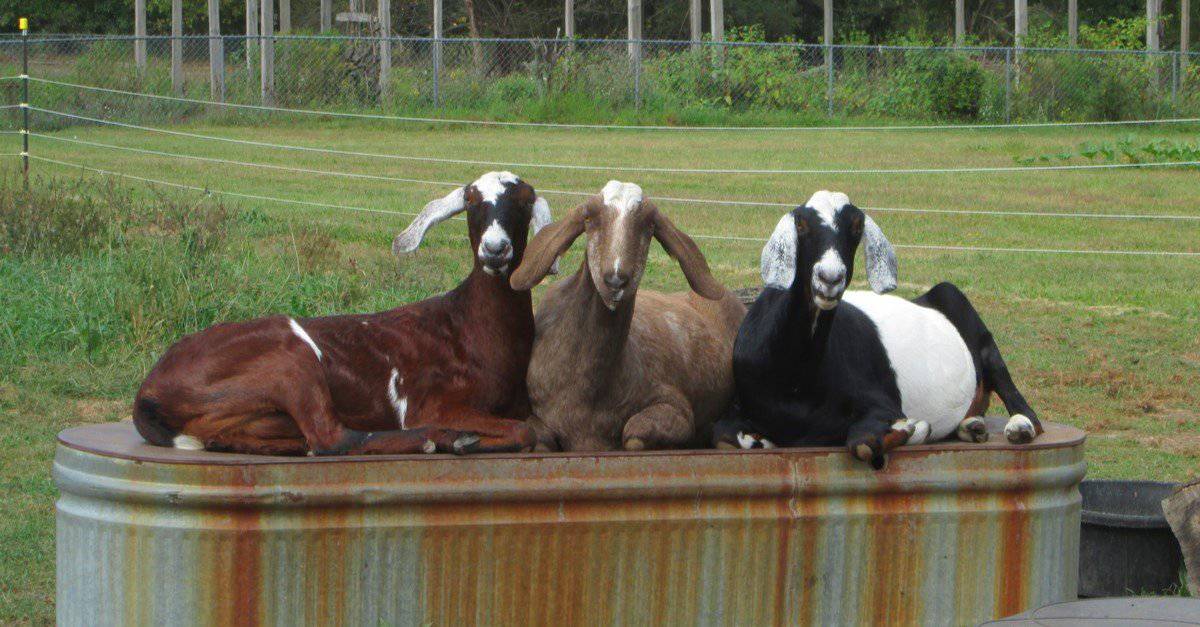
Nubian goats come in various colors although the most common color is a blend of brown and white.
©Bailey Davenport/Shutterstock.com
All goats have split (cloven) hooves, horns, and beards. Goats are classed as ungulates (hooved) and ruminants.
Lop-ear goats stand out for their size. They are taller and stockier than average dairy goats. They also stand out for their rounded faces, long curved noses, and short, glossy coats.
They come in various colors, including golden brown, reddish-brown, black, and dark gray. The most common color is a blend of brown and white.
Typically, the Nubian goat has black or white markings on its face. Their long, silky ears might be brown, white, or black.
Mixed breeding contributes to their unusual, beautiful looks. British goat farmers created the Nubian by breeding goats from Africa, India, and the Middle East. This ancestry is why some people refer to Nubians as Anglo-Nubians.
Habitat
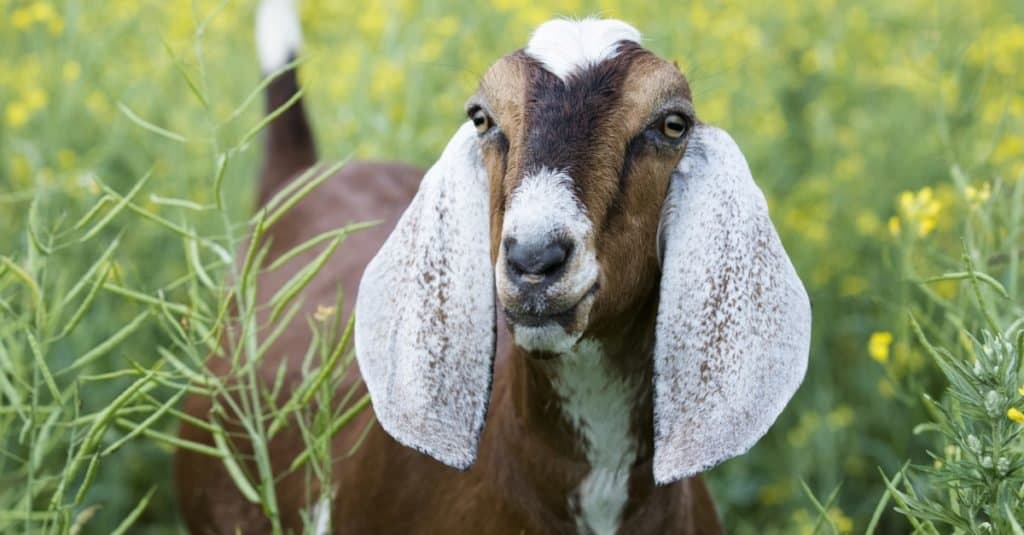
Nubian Goats are highly adaptable and suited to small farms and homesteads.
©Liliya Kulianionak/Shutterstock.com
Lop-ear goats are highly adaptable to many environments. Goats can survive on sparse vegetation. They are not picky about their food and will happily graze on shrubs, brush, poison ivy, and fallen leaves.
If you have these goats, you can let them roam your fenced pastures.
Lop-ear goats are highly suited to small farms and homesteads. Compared to cows and sheep, goats are small and easy to handle. Like all domestic animals, however, they need their own dedicated shelters. Domestic goats cannot tolerate extremes of hot and cold the way wild goats can.
Because they are an adaptable, popular breed, you can find lop-ear Nubian goats for sale in many places. A single goat generally costs from $300 to $800. Females cost more.
In Zoos
If you’re not ready for a Lop-ear goat for sale, you can still enjoy these goats. Lop-ear goats are popular in zoo exhibits. You can see one at the Maryland Zoo in Baltimore or the Houston Zoo.
The Central Park Zoo in New York City has miniature Nubian goats. The Oregon Zoo has a miniature Nubian who is a featured YouTube performer. Assiniboine Park Conservancy in Manitoba, Canada, also has Nubian goats.
Diet
Lop-ear goats need hay, freshwater, grasses, and grains. Many goats forage in pastures, where they are happy to eat weeds, shrubs, and grasses. It’s important to keep them fenced and safe from predators if they roam. Most goats appreciate a salt block to lick.
Predators And Threats
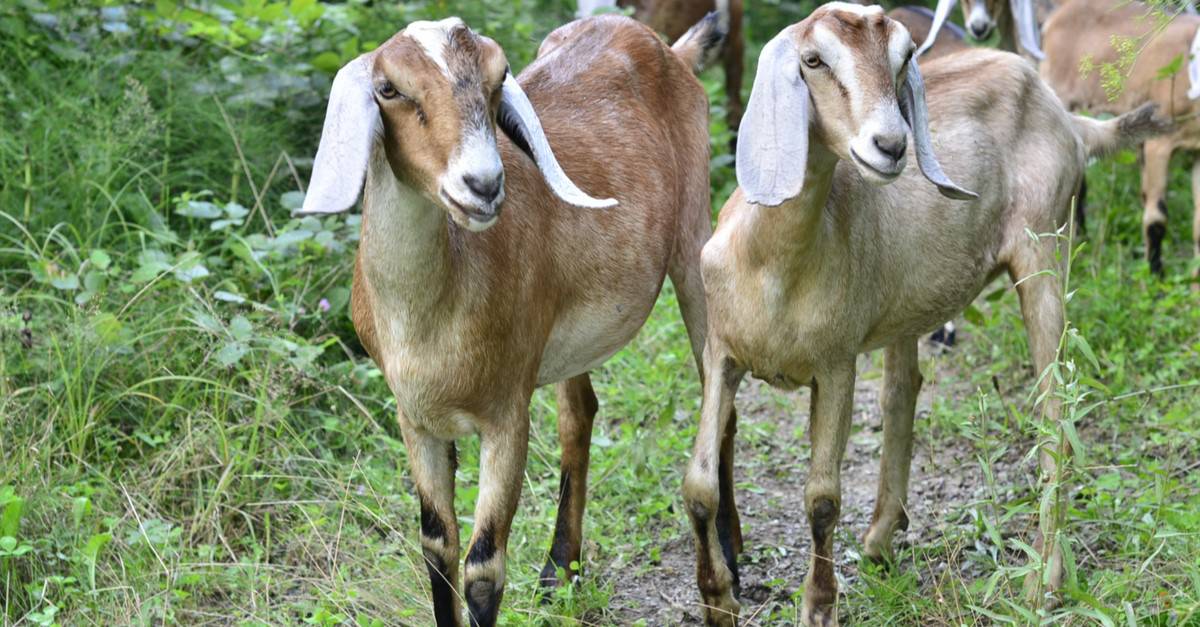
Stray dogs cause most of the attacks on domestic goats but coyotes, foxes, wolves and bobcats are a threat as well.
©Zhanna Shamrai/Shutterstock.com
Lop-ear goats face two major threats: predators and parasites.
Predators
Wild animals are a threat to wild and domestic goats. Stray dogs cause most of the attacks on domestic goats. If you allow your goats to roam freely on your property, consider getting a livestock guardian animal like a dog or donkey.
Coyotes, foxes, wolves, and bobcats will attack domestic goats. It may also surprise you to see eagles and other raptors diving for baby goats. They are especially dangerous during the kidding season when they know there may be unattended kids in the fields.
To protect your lop-ear goats from these predators:
- Install secure electric fencing to keep predators out and goats in.
- Provide your goats with shelter at night.
- Keep your yard clean of brush, trash, and animal waste that can attract predators.
- Get a livestock guardian animal. You can use dogs, alpacas, female donkeys and llamas. It’s best if you raise them together from a young age to ensure the guardian bonds to the goats.
Parasites
Parasites are the biggest threat to Nubians as they are to all domestic goats. All goats should be treated for worms as part of their regular veterinary care.
As domestic animals, Nubians depend on their humans for care and protection. If you’re considering getting a Nubian goat, you must include veterinary and other costs besides the “for sale” price. Goats need vaccinations and regular veterinary care. They also need protection from predators.
Reproduction, Babies, And Lifespan
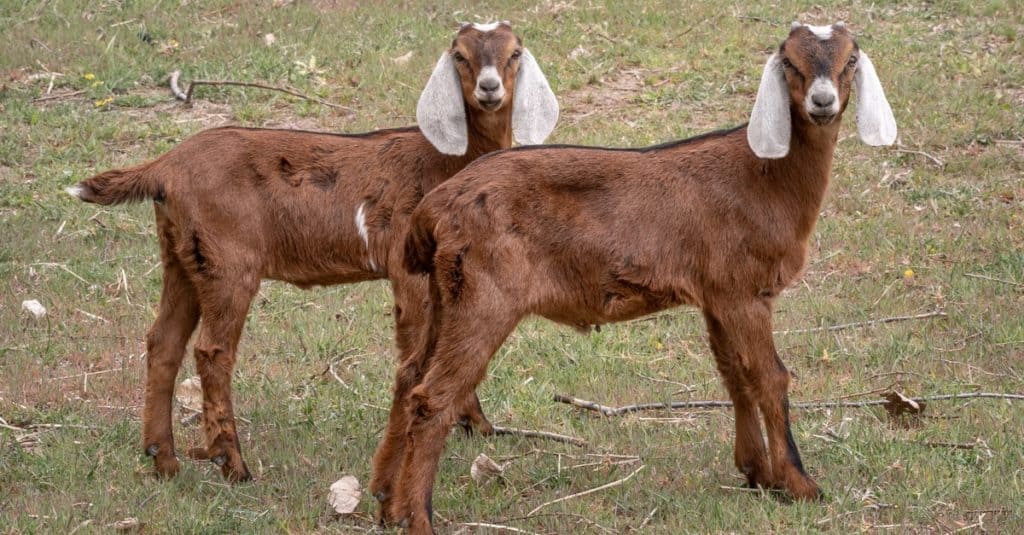
Twin Nubian Goat kids – kids begin eating grass and other solid foods 2 months after birth.
©Melinda Stanfield/Shutterstock.com
These goats can live 15 years or more if they’re healthy and properly cared for.
Male goats are known as billies or bucks. Castrated males go by the name wethers. Females are called nannies or does. Baby goats are known as kids, but they can also be called bucklings or doelings.
Nubian bucks are sexually mature at six months. Like deer, they reproduce in the fall. During this time, the males emit a strong musky odor.
After mating, the doe gets pregnant. The gestation period lasts 150 days and may include a single baby, twins, or triplets. A few nannies will have four or five kids, but that’s unusual.
These goats are fertile their entire lives. That’s a lot of potential kids.
These goats are excellent mothers who stay close to their kids for the first few weeks of their lives. After about two months, kids begin eating grass and other solid foods.
Population
There are more than 370,000 of these goats in the U.S. There are over one billion domestic goats in the world, and most of them are dairy goats.
Some wild goat species are threatened, but no domestic goat species are endangered.
View all 65 animals that start with NNubian Goat FAQs (Frequently Asked Questions)
What Is a Nubian Goat?
A Nubian goat is a dairy goat known for its long, silky ears, large size, and high quality of its milk. It is sometimes called an Anglo-Nubian goat.
How Much Milk Does a Nubian Goat Produce?
A Nubian goat can produce a full gallon of milk each day. This is less than other dairy goats, but the milk is prized for its high quality and sweet taste.
What Are Nubian Goats Good For?
Their primary purpose is to produce milk. They are smart enough for almost any purpose, however, including as pets or show goats. Nubian goats in zoos are very popular with zoo visitors, and they work well as zoo ambassadors.
Are Nubian Goats Friendly?
Nubian goats have a friendly, outgoing temperament. Like most goats, they are quick learners who are willing to be trained.
Nubian goats are highly vocal and like to follow their people around calling to them. Some people may find that annoying, but others find this endearing. If you like a vocal, slightly clingy temperament, you will like a Nubian goat.
How Big Do Nubian Goats Get?
They are among the largest dairy goats. In fact, the American Goat Society (AGS) states a Nubian goat must weigh a minimum of 130 pounds and stand 2.5 feet tall. Male Nubians can weigh around 160 pounds and stand 3 feet tall.
What is the Temperament of a Nubian Goat?
An Anglo Nubian goat is lively and inquisitive. They are quick to learn. These goats want to bond with humans and work with them. You can use them for dairy, farm shows, or almost any other purpose. Some people dislike the way Nubians seem to bleat constantly, but others enjoy their vocalizations. If you want a quiet goat, Nubians are not the right choice.
All goats are sociable. Nubians are happiest with other goats, but they also enjoy donkeys, horses, and sheep for company.
Thank you for reading! Have some feedback for us? Contact the AZ Animals editorial team.
Sources
- Morning Chores, Available here: https://morningchores.com/nubian-goat/#:~:text=
- Allied Market Research, Available here: https://www.alliedmarketresearch.com/goat-milk-market

















